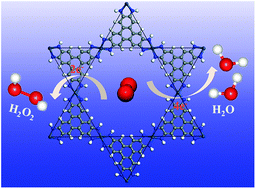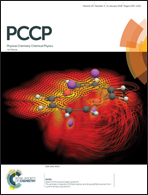Theoretical insights into the catalytic mechanism for the oxygen reduction reaction on M3(hexaiminotriphenylene)2 (M = Ni, Cu)†
Abstract
Recently two dimensional (2D) metal–organic frameworks have been successfully used as electrocatalysts, which exhibited a high catalytic activity. Herein, we investigated the catalytic mechanism of the oxygen reduction reaction (ORR) on M3(hexaiminotriphenylene)2 (M3(HITP)2, M = Ni, Cu) in an acidic medium using the density functional theory (DFT) method. The results indicate that the first electron transfer (ET) to nonadsorbed O2 is a process of long-range ET on the outer Helmholtz plane (i.e. the ET-OHP mechanism). On the surface of M3(HITP)2 (M = Ni, Cu), both the 2e reduction pathway and the 4e reduction pathway are feasible, while the 2e pathway to form H2O2 is more favorable. In the several competing reactions for the 4e reduction pathway on M3(HITP)2, the favorable path is OOH* → O* + H2O → OH* → H2O. Our study provides theoretical guidance for gaining deeper insights into the reaction mechanism of the ORR on M3(HITP)2 (M = Ni, Cu) catalysts.



 Please wait while we load your content...
Please wait while we load your content...